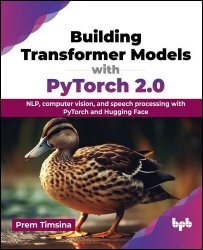 Название: Building Transformer Models with PyTorch 2.0: NLP, computer vision, and speech processing with PyTorch and Hugging Face
Название: Building Transformer Models with PyTorch 2.0: NLP, computer vision, and speech processing with PyTorch and Hugging FaceАвтор: Prem Timsina
Издательство: BPB Publications
Год: 2024
Страниц: 310
Язык: английский
Формат: pdf, epub (true)
Размер: 12.7 MB
Your key to transformer based NLP, vision, speech, and multimodalities.
Key features:
- Transformer architecture for different modalities and multimodalities.
- Practical guidelines to build and fine-tune transformer models.
- Comprehensive code samples with detailed documentation.
Description:
This book covers transformer architecture for various applications including NLP, computer vision, speech processing, and predictive modeling with tabular data. It is a valuable resource for anyone looking to harness the power of transformer architecture in their machine learning projects.
The book provides a step-by-step guide to building transformer models from scratch and fine-tuning pre-trained open-source models. It explores foundational model architecture, including GPT, VIT, Whisper, TabTransformer, Stable Diffusion, and the core principles for solving various problems with transformers. The book also covers transfer learning, model training, and fine-tuning, and discusses how to utilize recent models from Hugging Face. Additionally, the book explores advanced topics such as model benchmarking, multimodal learning, reinforcement learning, and deploying and serving transformer models. In conclusion, this book offers a comprehensive and thorough guide to transformer models and their various applications.
Lately, transformer architecture has appeared as a swiss knife for Machine Learning architecture. The transformer architecture is at the heart of most recent breakthroughs in Generative Artificial Intelligence. For instance, tools like ChatGPT and BARD, perceived by many as paving stones towards artificial general intelligence, are built on Transformer foundations. Thus, it is imperative for data scientists, ML Engineers, and Technologists to understand how this architecture can solve various ML tasks.
This book provides both theoretical and practical understanding of transformer architecture. Specifically, we will cover these ML tasks: Natural Language Processing (NLP), Computer Vision, Speech Processing, Tabular Data Processing, Reinforcement Learning, and Multi-Modalities. Center to the book are four major ML tasks, each explored in depth across two chapters. The initial chapter lays the groundwork by discussing the conceptual understanding. Here, we discuss the inner working of transformer architecture to solve tasks and discuss the architecture of major foundational models. Following this, the subsequent chapters focus on the practical understanding of pre-training, fine-tuning and using open source models to solve the ML tasks. This book will demonstrate practical applications through several comprehensive, end-to-end projects.
To equip with comprehensive understanding, the book has dedicated chapters for Hugging Face Ecosystem, transfer learning and deploying and serving transformer models. We will also delve deeper into best practices and debugging transfomer model developed utilizing PyTorch and Hugging Face.
The pre-requisite for this book is basic understanding of PyTorch and Deep Learning. This book will benefit data scientists and ML engineers who are seeking to enhance their knowledge of transformer models and learn how to develop ML engines using the transformer architecture and Hugging Face’s transformer library. It will also be valuable for developers and software architects looking to integrate transformer-based models into their existing software products. Additionally, AI enthusiasts interested in the latest developments in cutting-edge ML methods will find this book useful. In summary, you will gain a conceptual understanding of transformer architecture and practical knowledge on how to solve various ML tasks using this architecture.
What you will learn:
- Understand the core architecture of various foundational models, including single and multimodalities.
- Step-by-step approach to developing transformer-based Machine Learning models.
- Utilize various open-source models to solve your business problems.
- Train and fine-tune various open-source models using PyTorch 2.0 and the Hugging Face ecosystem.
- Deploy and serve transformer models.
- Best practices and guidelines for building transformer-based models.
Who this book is for:
This book caters to data scientists, Machine Learning engineers, developers, and software architects interested in the world of generative AI.
Скачать Building Transformer Models with PyTorch 2.0: NLP, computer vision, and speech processing with PyTorch and Hugging Face